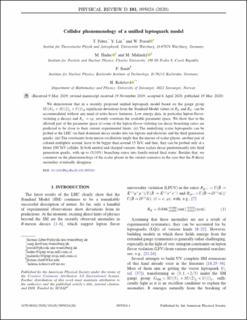| dc.contributor.author | Faber, T. | |
| dc.contributor.author | Liu, Y. | |
| dc.contributor.author | Porod, W. | |
| dc.contributor.author | Hudec, M. | |
| dc.contributor.author | Malinsky, M. | |
| dc.contributor.author | Staub, F. | |
| dc.contributor.author | Kolesova, Helena | |
| dc.date.accessioned | 2021-05-19T08:43:48Z | |
| dc.date.available | 2021-05-19T08:43:48Z | |
| dc.date.created | 2020-11-12T12:14:58Z | |
| dc.date.issued | 2020-05 | |
| dc.identifier.citation | Faber, T., Liu, Y., Porod, W. et al. (2020) Collider phenomenology of a unified leptoquark model, Physical Review D, 101(9). | en_US |
| dc.identifier.issn | 2470-0010 | |
| dc.identifier.uri | https://hdl.handle.net/11250/2755597 | |
| dc.description.abstract | We demonstrate that in a recently proposed unified leptoquark model based on the gauge group SU(4)C×SU(2)L×U(1) R significant deviations from the Standard Model values of R K and R K ∗ can be accommodated without any need of extra heavy fermions. Low energy data, in particular lepton-flavor-violating μ decays and K L → e μ , severely constrain the available parameter space. We show that in the allowed part of the parameter space (i) some of the lepton-flavor-violating tau decay branching ratios are predicted to be close to their current experimental limits. (ii) The underlying scalar leptoquarks can be probed at the LHC via their dominant decay modes into tau leptons and electrons and the third generation quarks. (iii) The constraints from meson oscillations imply that the masses of scalar gluons, another pair of colored multiplets around, have to be bigger than around 15 TeV, and thus, they can be probed only at a future 100 TeV collider. In both neutral and charged variants, these scalars decay predominantly into third generation quarks, with up to O (10 %) branching ratios into family-mixed final states. Besides that, we comment on the phenomenology of the scalar gluons in the current scenarios in the case that the B-decay anomalies eventually disappear. | en_US |
| dc.language.iso | eng | en_US |
| dc.publisher | American Physical Society | en_US |
| dc.rights | Navngivelse 4.0 Internasjonal | * |
| dc.rights.uri | http://creativecommons.org/licenses/by/4.0/deed.no | * |
| dc.subject | fysikk | en_US |
| dc.title | Collider phenomenology of a unified leptoquark model | en_US |
| dc.type | Peer reviewed | en_US |
| dc.type | Journal article | en_US |
| dc.description.version | publishedVersion | en_US |
| dc.subject.nsi | VDP::Matematikk og Naturvitenskap: 400::Fysikk: 430 | en_US |
| dc.source.pagenumber | 20 | en_US |
| dc.source.volume | 101 | en_US |
| dc.source.journal | Physical Review D | en_US |
| dc.source.issue | 9 | en_US |
| dc.identifier.doi | 10.1103/PhysRevD.101.095024 | |
| dc.identifier.cristin | 1847370 | |
| dc.source.articlenumber | 095024 | en_US |
| cristin.ispublished | true | |
| cristin.fulltext | original | |
| cristin.qualitycode | 1 | |

